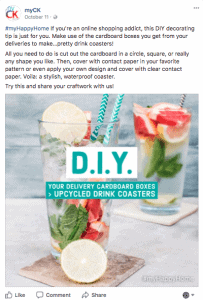Brand Storytelling In Content Marketing
One of the most common mistakes and missed opportunities for brands practicing content marketing is a lack of brand storytelling.
Brand Storytelling is all about letting the public know what your company is about, and what it stands for.
For many marketers, the sentiment is similar: “But this content has nothing to do with my product! It doesn’t mention any important features or sales! How can I track the ROI?”
True, some branding campaigns will have nothing to do with your latest product, but your brand is a product you’re always selling.
A study by Nielsen showed that consumers were more likely to trust brands they recognised, and based our own shopping habits, it’s easy to see that building a brand does matter.
Apple is known for it’s state of the art design, Nike for inspiring sports stars, take a second to think about what your brand is known for.
What are the values your brand supports, how and why did the brand start, what kind of challenges has it faced?
1. Rethink your approach to marketing product

We often think about marketing our products the same way, touting its special features and USPs and so on.
But as marketers, we sometimes lose track of what they are really buying:
People don’t just buy products because they want them, they buy them to fulfill a need.

Most consumers don’t buy Nike sports shoes for hundreds of dollars because they need sports shoes, they do it because they want to be the best, to be victorious which is what they perceive Nike products will be able to help them achieve.
A good way to think about the core needs your product fulfills is to think about what happens when a consumer uses it.
What are they doing, thinking and feeling – how different are these answers when compared to the lowest cost option?
Understanding what your consumer really wants is key when you’re marketing your product and when you’re trying to create content.
2. There is no way to perfectly calculate the ROI of your content

This is probably the number one question most marketers who are familiar with content marketing have.
The common answers are pretty standard, interactions, shares, email open rates, clickthrough rates, bounce rate, time on site etc…
But each of these measurements are flawed on their own and are affected by many other factors.
For example, research has shown that people share and like articles without even reading them.
I may have spent 10 minutes on your site because I clicked on the link, left for a cup of coffee and totally forgot about it, the list goes on.
But why are so many advertisers still clinging on to these metrics to measure performance?
Sadly, it’s because alternatives that involve big data management and analytics are currently too expensive for most brands to afford.
Kraft for example measured the results of their campaign by tagging 22,000 different data points across their web content and observing millions of interactions with the help of dedicated software and a capable team.
It’s by no means easy, but through the process, Kraft has managed to prove that their content works 4x better than traditional advertising.
While the metrics used may be similar to what we’re familiar with, they are rarely taken as a single point of reference but is compared across thousands of data points to determine relevancy.
Metrics like interactions or reach, while not perfect are your best bet for now, just take your results with a pinch of salt, and remember that it doesn’t tell the full story.
3. Set goals, think creatively
Content can be a great tool to share the ideas behind your brand, but it’s also a great problem solving tool if used properly.
Think about how your brand and product is fulfilling your audience’s needs and how you can deliver it more with content.
For example, myCK, a local department store targets heartland families and more specifically women who tend to do most of the shopping.

Heartland mothers want to be good mothers, providing for their family, making sure their kids grow up safe and enjoying a happy family life.
In response to this, myCK shares household tips from cleaning tips to simple crafting recipes all mothers can try and gain value from.
While there’s no direct link to any product or overt branding, it helps to reinforce the values the brand and the audience shares.
It also establishes the brand as a one that is interested and invested in adding value to their consumers, not just another brand that wants to take your money.
That’s what brand value is all about!
Another approach you can take is to think along the lines of problem solving.
Is there something you wish your consumers knew? Or a certain behaviour you’d like to inculcate? How can content help you achieve that in a fun, meaningful way?

Origins launched their new GinZing line of products in August.
Like any new product in the market, there are growing pains, and the top priority for the brand was awareness.
In response, they built a campaign and held a contest to recruit brand ambassadors from a pool of their loyal fans.
The fan base quickly got into action and took pictures of themselves with GinZing products and samples and spread awareness of these new products to their friends and followers.
On top of that, the winners continued to create high quality content on Instagram to share with their friends and to be used on the Origins page.
Similarly, Lego had a similar idea to tap into their users with The George Sighting Competition.

Lego identified that their customers loved sharing their creations online and on social media in creative ways.
In response the held a photo contest where fans were encouraged to build a George of their own and take pictures of him in cool locations.
By zeroing in on how their fans interacted with their products on social media, Lego managed to create a platform where their fans could share with like minded people and get inspired to create!
4) Dig into the right stories
What makes Chanel mean what it means today? Sure, they make some great bags and other fashion products, but so do other brands.
Instead, the story of the brand is synonymous with Gabrielle Chanel or sometimes better known by her nickname, Coco Chanel.
Even if you’re not familiar with Gabrielle, you know that Chanel is a luxury brand and vastly important in the world of high fashion.
This narrative was created years ago by Gabrielle herself, as a headstrong woman in an industry dominated by men.
She was one of the first female fashion designers and stood for female empowerment and elegance.
Today her story is told not only in employee handbooks or on their website, but books and movies as well.
While your brand might not have someone as boisterous as Gabrielle, there are always stories of passion, pride or innovation that show what your brand is all about.
Maybe your founder came from a long line of watchmakers and decided to modernise the designs, or maybe your founder saw a problem in the shipping industry that inspired him to come up with a solution!
It’s stories like these that paint the vision of your brand in the minds of the public and enable you to compete beyond just price.
Content can help you spread your message whether it’s a video, article or any other kind of media, it’s important to get this information out there.
Again, there’s no real way to calculate an ROI for a campaign like this beyond consumer brand recognition surveys, but the effect is apparent and necessary in the long run.
What’s your brand story?
Brand storytelling is a long term strategy, and you might not see immediate results.
However, it’s an incredibly important facet of content marketing that continues to fall to the wayside due to our obsession with ROI.
Find your story, and share it with your fans!
Once again, feel free to drop us any questions or comments or even to share some of your ideas with us at this email: enquiries@clickrmedia.com






